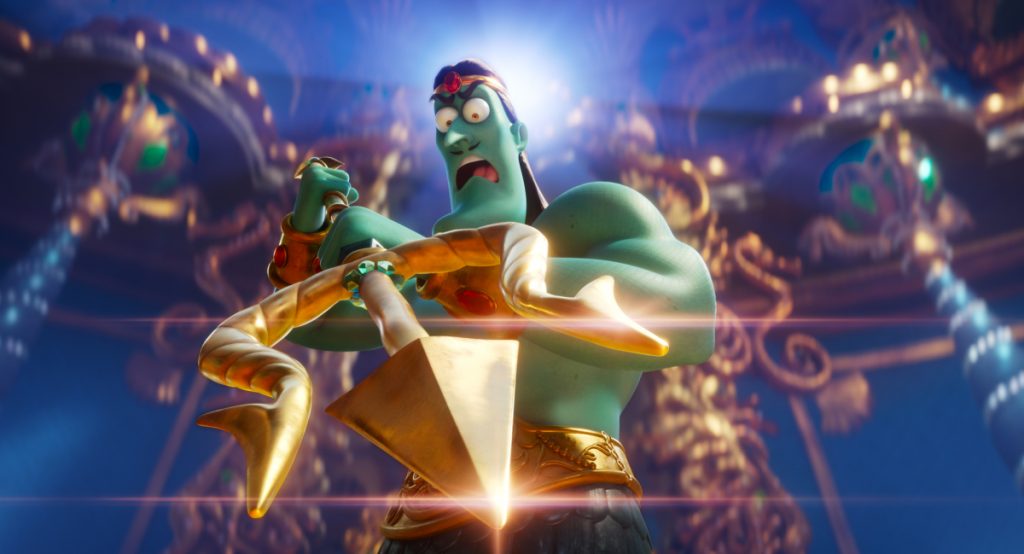March 3, 2021
by Carla Hay

“The SpongeBob Movie: Sponge on the Run”
Directed by Tim Hill
Culture Representation: Taking place in the fictional, underwater places of Bikini Bottom and the Lost City of Atlantic City, the live-action/animated film “The SpongeBob Movie: Sponge on the Run” features a predominantly white voice cast (with some African Americans, Asians and Latinos) in a comedic adventure story that’s part of the SpongeBob SquarePants franchise.
Culture Clash: SpongeBob SquarePants and his neighbor Patrick Star go on a mission to rescue SpongeBob’s best friend/pet snail Gary, which is being held captive by an egotistical overlord named King Poseidon.
Culture Audience: “The SpongeBob Movie: Sponge on the Run” will appeal primarily to people who are fans of the SpongeBob SquarePants franchise and people who like family-friendly animation that can be enjoyed by various generations.

As the first computer-generated imagery (CGI) animated movie in the SpongeBob SquarePants franchise, “The SpongeBob Movie: Sponge on the Run” is an exuberant and eye-catching adventure that makes up for some predictable moments with just enough unexpected zaniness to make it worth watching for anyone who appreciates earnestly goofy animation. It’s not necessary to see any episodes of the long-running Nickelodeon animated series “SpongeBob SquarePants” or its spinoff movies (“Sponge on the Run” is the third one in the film series) to enjoy the movie, although it certainly provides some better context for some of the relationships in the movie.
“The SpongeBob Movie: Sponge on the Run” has several scenes that are flashbacks to some of the characters’ childhoods. It’s an obvious promotion for “Kamp Koral: SpongeBob’s Under Years,” the prequel spinoff “SpongeBob” TV series that launches on Paramount+ (formerly known as CBS All Access) on the same day that “The SpongeBob Movie: Sponge on the Run” is available on the streaming service. “Kamp Koral” focuses on what some of the main characters did as children at Kamp Koral, and “The SpongeBob Movie: Sponge on the Run” gives a sense of what people can get expect from this spinoff TV series.
Written and directed by Tim Hill, “The SpongeBob Movie: Sponge on the Run” is the first “SpongeBob” movie to be released since the 2018 death of SpongeBob SquarePants creator Stephen Hillenburg, who died of amyotrophic lateral sclerosis (ALS) at the age of 57. The movie has a dedication to Hillenburg before the end credits. Compared to 2004’s “The SpongeBob SquarePants Movie” and 2015’s “The SpongeBob Movie: Sponge Out of Water,” there’s a slightly wackier vibe to “The SpongeBob Movie: Sponge on the Run,” thanks in large part to an amusing featured role from Keanu Reeves.
Things in the underwater city of Bikini Bottom are what SpongeBob fans can expect: SpongeBob SquarePants (voiced by Tom Kenny), the cheerfully upbeat sponge protagonist, is still working as a fry cook at a fast-food restaurant called the Krusty Krab, which is owned by his cranky Scottish boss Mr. Krabs (voiced by Clancy Brown). The pessimistic Squidward Tentacles (voiced by Rodger Bumpass) also works at the Krusty Krab. The tiny green copepod named Plankton (voiced by Mr. Lawrence) and his computer wife Karen (played by Jill Talley) are still scheming to get the secret recipe formula for the Kristy Krab’s Krabby Patty burgers, in order to boost Plankton and Karen’s failing rival restaurant the Chum Bucket.
This time, there’s a new challenge: SpongeBob’s best friend/pet snail Gary (also voiced by Kenny, who makes Gary sound like a cat) is stolen by Plankton, who gives Gary to the vain and tyrannical King Poseidon (voiced by Matt Berry) because the king uses snail slime to keep his face looking youthful. King Poseidon ran out of snails and offered a reward to anyone who could provide him with a useful snail. Plankton sees that offer as an opportunity to try to get in the king’s good graces and get revenge on SpongeBob. King Poseidon lives at Poseidon Palace, which is located in the Lost City of Atlantic City.
What follows is a madcap trek that involves SpongeBob and his amiable starfish neighbor Patrick Star (voiced by Bill Fagerbakke) going on a mission to find and rescue Gary. Along the way, they end up in a Western ghost town, where they have some off-the-wall encounters with flesh-eating zombie pirates (portrayed by live actors), a rapping gambler (played by Snoop Dogg) and a villainous zombie cowboy called El Diablo (played by Danny Trejo). But some of the funniest scenes in the movie are with a giant, advice-giving tumbleweed named Sage that rolls into SpongeBob and Patrick’s lives when they first arrive in the ghost town. Sage is a tumbleweed with a talking head of Reeves inside the center.
Also part of these antics is a new automated computer robot named Otto (voiced by Awkwafina), which the brainy squirrel Sandy Cheeks (voiced by Carolyn Lawrence) has given as a gift to Mr. Krabs. However, Mr. Krabs quickly gets annoyed with Otto and throws the robot away. Otto ends up becoming a crucial part of how the story develops.
The movie also has some cameos of celebrities playing a version of themselves as underwater animated characters that work at a nightclub in the Lost City of Atlantic City. Tiffany Haddish appears briefly on stage as a wisecracking fish that’s a stand-up comedian named Tiffany Haddock. Jazz saxophonist Kenny G plays a plant called Kelpy G, which does a smooth jazz version of “My Heart Will Go On,” the theme from the 1997 movie “Titanic.” It’s a somewhat subversive song choice, considering “Titanic” is a disaster movie where most of the characters end up drowning in the ocean.
There are some other endearingly oddball and unexpected choices in the movie, such as a criminal trial that takes place at the nightclub. The King Poseidon character plays with masculine and feminine stereotypes, by blurring the lines between obsessions with machismo and obsessions with beauty products. It’s why King Poseidon is not a typical villain in an animated film.
“The SpongeBob Movie: Sponge on the Run” clearly knows its audience well, since it’s made for kids as well as adults. “SpongeBob SquarePants” has been on the air since 1999; therefore, many of the kids who grew up watching the show now have children of their own. It explains the inclusion of Reeves, Snoop Dogg, Kenny G and Danny Trejo as cameos, since these stars’ pop culture significance have a different meaning to people who are old enough remember the 1990s and early 2000s.
The movie’s very retro music soundtrack is definitely geared more to adults, with rock and pop tunes from the late 20th century, such as Foghat’s “Slow Ride,” Willie Nelson’s “On the Road Again” and Ricky Martin’s “Livin’ La Vida Loca.” Weezer has two songs on the soundtrack: “It’s Always Summer in Bikini Bottom” and a cover version of a-ha’s “Take on Me” and the original song Also on the soundtrack is the Flaming Lips’ “Snail: I’m Avail.”
Mikros did the movie’s vivid CGI and animation, which is not as outstanding as a Pixar movie, but it’s better than most CGI animated films. Writer/director Hill moves things along at a brisk-enough pace, even though it’s very easy to know how the movie is going to end. “The SpongeBob Movie: Sponge on the Run” imparts a lot of positive messages of self-acceptance, but the characters have enough foibles and flaws to make the jokes relatable to viewers. Watch this movie if you like animated films and you’re up for an energetic diversion that might make you want more “SpongeBob” movies, regardless of how familiar or unfamiliar you might be with the franchise.
Paramount Pictures’ Paramount Animation and Nickelodeon Movies will release “The SpongeBob Movie: Sponge on the Run” on Paramount+ on March 4, 2021, the same date that Paramount Home Entertainment releases the movie on VOD. The movie was released in Canada in 2020.
